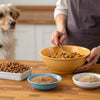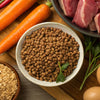What to Feed a Dog That Won't Eat Kibble: A Comprehensive Guide
- Houndsy
Table of Contents
- Introduction
- Understanding Why Dogs Refuse Kibble
- Alternatives to Kibble: What to Feed a Picky Eater
- Encouraging Your Dog to Eat
- The Importance of High-Quality Ingredients
- Conclusion
Introduction
Have you ever placed a bowl of kibble in front of your furry friend only to watch them turn their nose up at it? This can be a frustrating experience for any loving dog owner. Surprisingly, studies show that around 25% of dogs may refuse their kibble at some point in their lives. Whether it's due to boredom, a change in health, or simply being picky, knowing what to feed a dog that won't eat kibble can help you navigate this common challenge.
In this blog post, we will explore the reasons behind your dog's sudden aversion to kibble and provide a variety of alternatives and solutions. By the end, you will have a clear understanding of options that cater to your dog's preferences while ensuring they receive a balanced diet. We’ll cover everything from homemade toppings and alternative diets to tips for encouraging your pup to eat their meals.
So, let's dive into the world of dog nutrition and feeding habits, keeping in mind that every dog is unique, and what works for one might not work for another.
Understanding Why Dogs Refuse Kibble
Before we explore what to feed a dog that won't eat kibble, it’s essential to understand the reasons behind this behavior. There can be several factors at play, including health issues, behavioral quirks, or simply a preference for different food types.
1. Medical Reasons
Sometimes, a dog's refusal to eat can be linked to underlying health issues. It's crucial to consult your veterinarian to rule out any medical conditions that may be affecting your dog's appetite. Here are some common medical issues that can contribute:
- Dental Problems: Painful gums or broken teeth can make eating kibble uncomfortable. If your dog suddenly refuses kibble but seems keen on soft food, a dental check-up is advisable.
- Gastrointestinal Issues: Problems such as nausea, upset stomach, or food allergies can lead to a loss of appetite. Dogs may associate their kibble with discomfort and choose to avoid it.
- Age-Related Changes: Older dogs may experience changes in taste or smell, making kibble less appealing. They may also develop health conditions that affect their desire to eat.
2. Behavioral Factors
Behavioral reasons can also contribute to a dog’s refusal to eat kibble:
- Training and Habits: If your dog has learned that refusing kibble earns them treats or human food, they may be playing a clever game. This behavior can be reinforced by offering table scraps or treats outside of mealtime.
- Boredom with Food: Dogs can become bored with their food, especially if they have been eating the same kibble for an extended period. Variety is not just the spice of life for humans; many dogs appreciate it too.
- Environmental Stressors: Changes in their environment, such as moving homes, new pets, or loud noises, can impact a dog's comfort and appetite.
Alternatives to Kibble: What to Feed a Picky Eater
If your dog is turning its nose up at kibble, it’s time to explore other options. Here are some alternatives that can help entice your dog back to the bowl.
1. Homemade Toppings
Adding a homemade topping to your dog's kibble can make it more palatable and nutritious. Here are some ideas:
- Fruits and Vegetables: Finely chopped or pureed fruits and vegetables like carrots, green beans, and apples can add flavor and texture. They are also low in calories and high in vitamins.
- Bone Broth: A splash of homemade or store-bought (low-sodium) bone broth can enhance the aroma and flavor of kibble, making it more appealing.
- Pumpkin Puree: Unsweetened pumpkin puree is not only tasty but also rich in fiber, which can aid digestion and settle an upset stomach.
- Cooked Eggs: Scrambled or boiled eggs can provide a protein boost and are often beloved by dogs. Just ensure there are no allergies before introducing eggs into their diet.
2. Canned Dog Food
Many dogs find canned food more appealing than kibble. When selecting canned food, look for high-quality options that contain real meat and minimal fillers. Canned food can be served alone or mixed with kibble to entice your dog to eat.
3. Fresh Dog Food
Fresh dog food brands like Ollie offer human-grade meals made with real ingredients. These meals are often more fragrant and palatable than traditional kibble and can be tailored to your dog’s specific dietary needs.
4. Raw Food Diets
Raw diets attempt to mimic a dog's natural eating habits, consisting of raw meats, fruits, and vegetables. However, this option requires careful planning and consultation with a veterinarian to ensure nutritional balance and safety.
5. Interactive Feeders
Sometimes, the way we present food can impact a dog's willingness to eat. Feeding from an interactive feeder or puzzle toy can make mealtime fun and stimulate their interest in food.
Encouraging Your Dog to Eat
Once you have selected an alternative food option, here are some strategies to encourage your dog to eat:
1. Establish a Feeding Routine
Setting a consistent feeding schedule can help regulate your dog’s appetite. Offer food at specific times and remove uneaten food after 15-20 minutes. This practice prevents your dog from grazing throughout the day and can encourage them to eat when food is available.
2. Limit Treats and Table Scraps
If your dog is filling up on treats or human food, they may not be hungry for their regular meals. Treats should comprise no more than 10% of your dog's daily caloric intake.
3. Create a Calm Eating Environment
Make mealtime a stress-free experience by ensuring your dog has a quiet and comfortable space to eat. Avoid distractions, and try feeding them in a calm area away from noise and other pets.
4. Use a Variety of Food Forms
If your dog enjoys variety, consider rotating between kibble, canned food, and fresh food. This can keep mealtime exciting and encourage your dog to eat.
5. Consult Your Vet
If your dog continues to refuse food, especially if there are signs of illness, consult your veterinarian. They can help determine if there are underlying health issues that need to be addressed.
The Importance of High-Quality Ingredients
Regardless of the food you choose, always ensure that it meets your dog’s nutritional needs. High-quality dog food should contain:
- Real Meat: Look for whole meats as the first ingredient, which indicates a protein-rich diet.
- Whole Grains or Vegetables: These provide essential carbohydrates and fiber.
- No Fillers or Artificial Additives: Avoid foods with excessive fillers, preservatives, or artificial colors.
Conclusion
Navigating your dog’s food preferences can be challenging, especially when they refuse kibble. By understanding the reasons behind their behavior and exploring various alternatives, you can find solutions that improve their eating habits and overall nutrition. Remember, it’s essential to consult your veterinarian if your dog’s refusal to eat persists, as it may indicate underlying health issues.
As we strive to simplify and elevate the dog feeding experience, we believe that the Houndsy Kibble Dispenser can play a significant role in making mealtime easier for both you and your pet. With its ergonomic design and perfect portion control, it can help establish a routine that your dog will appreciate.
If you’re looking for a stylish and functional way to enhance your dog’s feeding experience, we invite you to check out the Houndsy Kibble Dispenser here.
FAQ
What should I do if my dog won't eat for more than 24 hours?
If your dog has not eaten for more than 24 hours, it's essential to consult your veterinarian. Prolonged refusal to eat can lead to health issues, and your vet can help determine if there are underlying problems.
Can I mix kibble with wet food?
Yes, mixing kibble with wet food can make it more appealing to your dog and provide a balanced diet. Just be sure to adjust portion sizes accordingly to avoid overfeeding.
How can I tell if my dog is being picky or if there's a health problem?
If your dog shows a sudden change in appetite, or if they are exhibiting other symptoms (like lethargy, vomiting, or diarrhea), it’s best to consult your veterinarian. If your dog has a history of being picky but is otherwise healthy, you can try some of the alternatives discussed.
Is it safe to feed my dog human food?
Some human foods are safe for dogs, while others can be harmful. Always consult your veterinarian before introducing new foods to ensure they are safe and healthy for your dog.
What are some signs of dental problems in dogs?
Signs of dental problems in dogs can include bad breath, difficulty chewing, swollen gums, or blood in their saliva. Regular dental check-ups are essential for maintaining your dog's oral health.
By understanding your dog’s needs and preferences, you can create a feeding routine that keeps them happy and healthy. Remember, every dog is unique, so don’t hesitate to experiment with different options until you find what works best for your furry companion.












